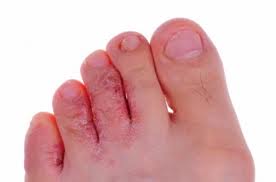What is Athletes Foot or Tinea Pedis? How to manage it? What are the precautions to be taken? What are the signs and symptoms? What is the cause of this disease? How to treat it? How can homeopathy help you? All of this answered, in this post and of course our doctors always there to help you. Just fill in your details in the form down below and we will answer all your questions for FREE!

What is Athlete Foot?
Tenia pedis is also known as athletes foot, ringworm of foot. It is an infection of foot by dermatophyte fungus which causes scaling, itching of the affected area and formation of flakes of skin. Athletes foot develops especially on the moist areas between your toes and sometimes on other parts of foot.
Tinea pedis infection thrives in warm humid conditions and is most common infection in young males.
Infection of tenia pedis is typically transmitted in moist communal areas where people walk barefoot such as showers or bathhouses. Tenia pedis fungus requires a warm moist environment to incubate and grow such as inside a shoe.
Tenia pedis commonly affect feet but it can also spread to other parts of the body and usually affect those parts of the body which are hot and moist such as the part where body heat is more with more perspiration for a long period of time.
Dermatophyte fungi enter the superficial keratin of the skin by using enzymes called keratinases and the infection remains limited to this layer of skin only.
The cell walls of dermatophyte contain mannans which inhibit the body’s immune response. Tenia rubrum in particular contains mannans that reduce proliferation of keratinocytes resulting in decreased rate of sloughing and chronic infectious state.
What are the Causes?
Tenia pedis occurs more frequently due to the following fungi
• Epidermophyton floccosum.
• Trichophyton interdigitale.
• Trichophyton rubrum.
Some predisposing factors leading to development of tinea pedis are as follows
• The fungi spores stay in bathrooms, changing rooms, swimming pools for months or years.
Some people are more prone to infection of tinea pedis. This may be because
Their skin produces less fatty acid.
They wear occlusive footwear.
They sweat heavily.
They have some kind of immune deficiency.
They have poor circulation resulting in cold feet as in case of lymphoedema.
Tenia pedis appear in various patterns and may affect one or both feet.It is mildly contagious.
Following type of symptoms appear
• In cases of chronic hyperkeratotic tinea there is fine dry scaling on the soles of feet.
• In some cases the skin of entire sole, heels, and sides of the foot is dry but no inflammation is seen.
• In athletes foot there is moist peeling irritable skin between the toes.It is most commonly between the cleft of fourth and fifth toes.
• In other cases it appears cluster or pustules on the sides of the feet or insteps.
• There are round dry patches on the top of foot.
What are the symptoms of athlete foot?
Symptoms of athlete’s foot, include:
itching, stinging, and burning between your toes or on soles of your feet
blisters on feet
cracking and peeling skin between your toes and on soles
dry skin on your soles or sides of your feet
toenails that pull away from the nail bed
What will happen if athlete’s foot is left untreated?
It can spread to a nail and cause a fungal infection. The infection may spread to other skin area, such as the hands, but it rarely happens. In severe cases of athlete’s foot, it can also lead to a bacterial infection as a complication.
Can Athlete’s Foot kill you?
No, it won’t kill you, but if it will remain untreated Athlete’s foot can lead to a bacterial infection.
Does athlete’s foot smell?
Normally, feet smell because they sweat inside shoes; bacteria then break down the sweat, producing compounds responsible for the offensive odor. Fungal infections of the feet like athlete’s foot can lead to bad foot odor
Can athlete’s foot spread to other parts of the body?
Athletes foot can spread to other parts of the body if you scratch and then touch other parts of your body, including your groin (jock itch) and the skin under your arms.
Should you wear socks with athletes foot?
Yes patient should wear synthetic socks which will wick away moisture. Cotton and wool socks trap the moisture and promote fungal growth. If not treated properly and, athlete’s foot can be very risky.
Homeopathic medicines for athletes foot:
Graphites
Silicea
Thuja occidentalis
Nitricum acidum
Sanicula aqua
For more information, you can visit MayoClinic and HealthLine.





